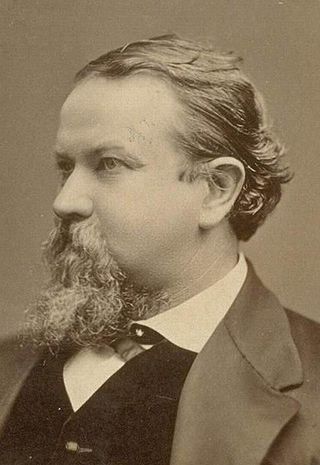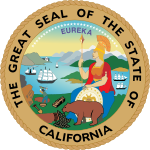
The 1856 United States presidential election was the 18th quadrennial presidential election, held on Tuesday, November 4, 1856. In a three-way election, Democrat James Buchanan defeated Republican nominee John C. Frémont and Know Nothing nominee Millard Fillmore. The main issue was the expansion of slavery as facilitated by the Kansas–Nebraska Act of 1854. Buchanan defeated President Franklin Pierce at the 1856 Democratic National Convention for the nomination. Pierce had become widely unpopular in the North because of his support for the pro-slavery faction in the ongoing civil war in territorial Kansas, and Buchanan, a former Secretary of State, had avoided the divisive debates over the Kansas–Nebraska Act by being in Europe as the Ambassador to the United Kingdom.

George Wallace Jones was an American frontiersman, entrepreneur, attorney, and judge, was among the first two United States Senators to represent the state of Iowa after it was admitted to the Union in 1846. A Democrat who was elected before the birth of the Republican Party, Jones served over ten years in the Senate, from December 7, 1848 to March 3, 1859. During the American Civil War, he was arrested by Federal authorities and briefly jailed on suspicion of having pro-Confederate sympathies.

Bleeding Kansas, Bloody Kansas, or the Border War was a series of violent civil confrontations in Kansas Territory, and to a lesser extent in western Missouri, between 1854 and 1859. It emerged from a political and ideological debate over the legality of slavery in the proposed state of Kansas.

The Lecompton Constitution (1858) was the second of four proposed constitutions for the state of Kansas. Named for the city of Lecompton where it was drafted, it was strongly pro-slavery. It never went into effect.

Milton Slocum Latham was an American politician, who served as the sixth governor of California and as a U.S. Representative and U.S. Senator. Latham holds the distinction of having the shortest governorship in California history, lasting for five days between January 9 and January 14, 1860. A Lecompton Democrat, Latham resigned from office after being elected by the state legislature to a seat in the U.S. Senate.

John Gately Downey was an Irish-American politician and the seventh governor of California from January 14, 1860, to January 10, 1862. Downey was the first governor of California to be born outside the United States. Downey was also the first man from Southern California to serve as governor.

There have been 91 gubernatorial elections in the state of New York since 1777, with the most recent being held on November 8, 2022. The next election is scheduled to be held on November 3, 2026.

The Kansas Republican Party is the state affiliate political party in Kansas of the United States Republican Party. The Kansas Republican Party was organized in May 1859.

Horatio Seymour was an American politician. He served as Governor of New York from 1853 to 1854 and from 1863 to 1864. He was the Democratic Party nominee for president in the 1868 United States presidential election, losing to Republican Ulysses S. Grant.

The 1858–59 United States House of Representatives elections were held on various dates in various states between June 7, 1858, and December 1, 1859. Each state set its own date for its elections to the House of Representatives. 238 representatives were elected in the new state of Oregon, the pending new state of Kansas, and the other 32 states before the first session of the 36th United States Congress convened on December 5, 1859. They were held during President James Buchanan's term.

The 1861 California gubernatorial election took place on September 4, 1861. Incumbent Governor John G. Downey was not a candidate for renomination, as his Democratic Party had violently ruptured over the issue of slavery and secession. Downey was a Lecompton Democrat, those who favored slavery in the Kansas Territory and who were running as now as the Breckenridge or "Chivalry" Democrats. These Chivalry Democrats supported Attorney General John McConnell. Anti-slavery or anti-secession Democrats were the "Unionist" Democrats who favored John Conness.

The California Democratic Party is the affiliate of the Democratic Party in the U.S. state of California. It is headquartered in Sacramento, the state capital.
The Democratic Party of Wisconsin is the affiliate of the Democratic Party in the U.S. state of Wisconsin. It is currently headed by chair Ben Wikler.

United States gubernatorial elections were held on November 5, 2002, in 36 states and two territories. The Republicans won eight seats previously held by the Democrats, as well as the seat previously held by Minnesota governor Jesse Ventura, who was elected on the Reform Party ticket but had since renounced his party affiliation. The Democrats won 10 seats previously held by the Republicans, as well as the seat previously held by Maine governor Angus King, an independent. The elections were held concurrently with the other United States elections of 2002.
The Maine Democratic Party is the affiliate of the Democratic Party in the U.S. state of Maine.

The presidency of James Buchanan began on March 4, 1857, when James Buchanan was inaugurated as 15th president of the United States, and ended on March 4, 1861. Buchanan, a Democrat from Pennsylvania, took office as the 15th United States president after defeating former President Millard Fillmore of the American Party, and John C. Frémont of the Republican Party in the 1856 presidential election.

The 1859 New Jersey gubernatorial election was held on November 8, 1859. Opposition Party nominee Charles Smith Olden defeated Democratic nominee Edwin R. V. Wright with 50.76% of the vote.
The 1852–53 Massachusetts gubernatorial election consisted of an initial popular vote held on November 8, 1852, followed by a legislative vote conducted on January 12, 1853, which elected Whig Party nominee John H. Clifford. The ultimate task of electing the governor had been placed before the Massachusetts General Court because no candidate received the majority of the vote required for a candidate to be elected through the popular election.
The 1850–51 Massachusetts gubernatorial election consisted of an initial popular held on November 11, 1850 that was followed by a legislative vote that was conducted on January 11, 1851. It saw the election of Democratic Party nominee Emory Washburn. The ultimate task of electing the governor had been placed before the Massachusetts General Court because no candidate received the majority of the vote required for a candidate to be elected through the popular election.

The 1833–34 Massachusetts gubernatorial election consisted of a popular election held on November 11, 1833, that was followed by a legislative vote held in January 1834. The ultimate task of electing the governor had been placed before the Massachusetts General Court because no candidate received the majority of the vote that was constitutionally required for a candidate to be elected through the popular election.



















